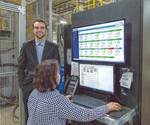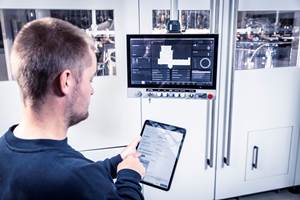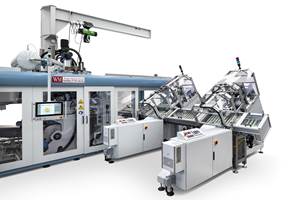Beyond the Work Center: Using MES for Data-Driven Decisions Across Manufacturing Operations
Move past “is the job running” and “will it finish on time,” and apply MES to inform workflows ranging from accounting, inventory control, planning, material logistics, quality assurance, engineering and shipping.

Fully exploit your manufacturing execution system (MES) software to acquire and assimilate production data from multiple sources. Source: DELMIAWorks
Mid-market plastics manufacturers have more power than ever to make data-driven decisions throughout their entire business operation, supported by modern, smart manufacturing equipment, the Internet of Things and manufacturing execution system (MES) software capable of acquiring production data from multiple sources. Yet most plastics processors only tap a portion of the capabilities these technologies provide, particularly when it comes to MES.
When we think of MES and production and process monitoring in plastics processing, we often focus on the benefits directly associated with the work center. For example: Is the job running? Will it finish on time? Are we producing good parts, and are the process parameters all within specification? That focus is understandable because MES primarily provides production monitoring built around machine-cycle counting and process monitoring that measures and records production parameters like temperature and pressure.
But the value of production and process monitoring extends well beyond the work center to inform workflows that range from accounting through to inventory control, planning, material logistics, quality assurance, engineering and shipping. This is particularly true where the MES functionality is fully integrated with — or better yet — built into the manufacturing enterprise resource planning (ERP) system.
MES Informs Upstream and Downstream Workflows
When MES information is fully integrated with the other core features of an ERP system, event information from production and process monitoring creates triggers that help orchestrate all the other upstream and downstream manufacturing workflows.
For example, if a job is running slow, then dispositioning material for the next job to the same slow work center creates confusion and the unnecessary shuttling of materials back and forth around the plant. Alternatively, a job may be producing scrap and consuming raw materials without producing finished goods. Not only do the scrap cycles delay production but the unplanned material shortage compounds the delay. In both cases, integrated real-time production monitoring captured by the MES could alert the appropriate departments, such as planning and purchasing, to make adjustments before complications become severe.
When deviations arise between true production costs and standard costs, you can determine the root cause and take corrective actions, modify the standard cost or even suggest the sale price be adjusted.
The most descriptive term to describe using MES data to inform upstream and downstream workflows is backflushing. Production events and counts are fed back into other manufacturing ERP functions to update information, such as predicted completion time; materials and labor consumed; inventory quantity on hand; quality issues; and finished goods available for shipment.
Aligning ERP Functionality With Plastics Processors’ Operations
Before looking at specific examples of how MES data can be used to improve operational workflows, it’s useful to review the manufacturing ERP functions that are very analogous to the workflows of actual manufacturing operations.
ERP financial features track everything from profit and loss and general ledger to cash flow, budgeting, accounts payable and accounts receivable operations of the business. Customer relationship management (CRM) programs keep track of customers, prospects, marketing efforts, sales orders and sales history. And human capital management (HCM) captures and organizes the employee information necessary for payroll, performance management and training.
Meanwhile, material resource planning (MRP) and supply chain management (SCM) are where the production planning, procurement and inventory control functions reside. For plastic processors, it is very important that the MRP and MES features be able to account for bill-of-material details and differences between various plastic processing types, such as injection molding, blow molding, thermoforming and extrusion, including factors such as cavities, runners, sprues, units of measure and regrind.
Two other key functional areas are the quality management system (QMS) and warehouse management system (WMS). The QMS provides the system of procedures, records and controls necessary for ensuring quality and traceability, while the WMS oversees both the flow of raw material into the warehouse and the flow of finished goods out to customers.
Not all shopfloor employees are qualified to perform all jobs, and not all employees perform their tasks at equal rates and quality levels.
Now, let’s examine some core workflows managed by these functions and how they can be automatically updated by real-time production information from the integrated MES to the entire plastics manufacturing operation.
Enable Accurate Production-Cost Accounting
Most plastics manufacturing operations are based on standard costs. However, if actual costs deviate from planned costs, a lack of visibility can lead to the introduction of financial errors that remain uncorrected until they severely impact profitability.
Real-time production monitoring, which measures actual machine, material and labor consumption results in true production costs that can then be frequently compared with standard costs. When deviations arise, analysts and engineers can determine the root cause of the differences and either take corrective actions, modify the standard cost, or even suggest the sale price be adjusted. Actual cost tracking using the MES and financial functionality keeps planned cost forecasting honest and results in much more accurate profit-and-loss reporting to drive overall business profitability.
Tip: You can base a continuous improvement program around the regular review of actual costs versus standard costs, focusing first on the larger deviations and then working down to the smaller variances.
Manage Workforce Qualifications and Performance
Not all shopfloor employees are qualified to perform all jobs, and not all employees perform their tasks at equal rates and quality levels. Two ways that MES complements HRM are its ability to only allow qualified operators to execute a job and its inherent tracking of quality and time on a job. To log into a job, an operator must present the proper credentials. And while a job is running, the operator’s performance is monitored and recorded. This provides management and the human resources department with the metrics they need to manage the qualification and performance of the workforce.
Tip: Set up alerts to notify supervisors when employee qualifications have expired and run regular reports to stay on top of employee certification schedules.
Provide Greater Predictability
Customers highly value predictable delivery times. Being able to advise customers on the exact status of their orders is a key measure of quality customer service. By combining real-time production monitoring data in the MES with other manufacturing ERP functions, plastics processors can more consistently provide customers with accurate order status and delivery dates.
Customers place a high value predictable delivery times. Being able to advise customers on the exact status of their orders is a key measure of quality customer service.
The status of a job; the availability of a machine; the rate of consumption of materials; and the final goods available for shipment are all essential data points for the planning, procurement and inventory control operations of the business. Production monitoring makes all this information available, so instead of these departments operating in a hoped-for best-case scenario — or worse, crisis mode — they function with real-time information that enables them to plan and course correct in synchronization with actual events on the shop floor.
Tip: If you have to move jobs to different machines, use ‘runs best’ historical data to pick the next best tool and machine combination to get the work done on time.
Facilitate Quality Assurance and Validation
In addition to production monitoring, process monitoring data captured in the MES is vital to many parts of a plastics manufacturer’s business, particularly quality assurance and engineering. Process monitoring records the actual production equipment, tooling and product quality conditions at the time of manufacture. Important variables such as pressures, temperatures, weight and physical measures are recorded in a time series of information that is associated with individual parts, lots or jobs.
Process monitoring data integrated with the QMS automatically provides quality assurance teams with the oversight they need to monitor and validate production specifications. It also delivers the documentation they may need to fulfill customer and auditor demands for proof of proper production procedures. For both the quality assurance and engineering department, the records kept by process monitoring provide the basis for statistical process control and data-driven, root-cause analysis. The ability to provide precise process control information to customers is also a key selling tool for the sales team.
Tip: Process parameter data is perfect for performing X Bar R Charts analytics and for providing evidence-based information to compliance auditors.
Execute Timely Shipping and Accounting Workflows
The shipping department is typically the last leg of a product’s journey through the factory. As production monitoring records the end of a production run and the availability of the finished goods, data from the MES can trigger updates and actions in the WMS. It can then alert the warehouse of the products available for shipment and initiate the pick, pack and ship workflow. These actions, in turn, quickly initiate delivery of the product to customers and alert accounting to begin the billing process, turning work output into revenue.
Tip: Set up alerts to drive both internal and external real-time product dispositions and notify accounting that billing can take place immediately.
Optimize Dashboards and KPIs
Key performance indicators (KPIs) measure progress in meeting the organization’s objectives. When informed by production and process monitoring information from the MES, KPIs move performance results out of the rearview mirror to create front-and-center views of operations so that problems are caught and solved quickly.
Dashboards provide an automated mechanism for publishing KPIs. They access information from all parts of the system and provide it to viewers in easily read formats, such as graphs and charts. In this way, dashboards can be viewed as a form of alert. Parameters are set on what to report, to whom and when — then they run on autopilot.
Tip: Use highly visible displays and audible alerts to bring immediate attention to the most important and fundamental KPIs of the business so the entire operation is aware and invested in the success of the operation.
Destination Industry 4.0
As the plastics industry drives toward the ideals of Industry 4.0, manufacturers keen to compete on a global stage look to interconnected technologies to streamline processes and maximize the efficiency of their entire organization. Real-time production- and process-monitoring data managed by the MES and integrated with the core enterprise management system enables end-to-end visibility and data-driven decision-making not only in the immediate work center but throughout the entire business. By making critical production results available to the entire business in real-time and in actionable detail, plastics processors can turn their organization-wide agility into a competitive advantage that drives growth and profitability.

AMA Plastics’ connected shop floor. Source: DELMIAWorks
About the authors: Steve Bieszczat is chief marketing officer for DELMIAWorks. Bieszczat is responsible for DELMIAWorks’ brand management, demand generation and product marketing. Prior to DELMIAWorks, he held senior marketing roles at ERP companies IQMS, Epicor and Activant Solutions. Steve’s focus is on aligning products with industry requirements as well as positioning DELMIAWorks with the strategic direction and requirements of the brand’s manufacturing customers and prospects. Steve holds an engineering degree from the University of Kansas and an MBA from Rockhurst University. Contact: 925-872-8863; Stephen.BIESZCZAT@3ds.com; www.delmiaworks.com
Brad Nurnberg has a mechanical engineering degree from Clemson University. After graduating with honors, he worked for five years in multiple manufacturing environments with a particular focus on process monitoring and measurement devices. In addition, he acquired extensive knowledge of many manufacturing processes, including injection molding, blow molding, extrusion, thermoforming and assembly.
Since 2022, he has held a Solution Engineering role with DELMIAWorks, where he is tasked with developing and configuring solutions within the ERP system to meet specific customer needs. Nurnberg is an expert in using ERP and production monitoring systems to bring control, visibility and efficiencies to manufacturing operations. Contact: 704-492-1847; Brad.nurnberg@3ds.com; www.delmiaworks.com
Related Content
Adding Remote Service Functions for PET Bottle Blowing
KHS has added features to its internet machine communications portal for PET stretch-blow molding.
Read MoreAutomation in Thermoforming on the Rise
Equipment suppliers’ latest innovations exemplify this trend driven by factors such as labor shortages, higher-speed thermoformers and tighter quality control.
Read MoreEquipment Suppliers Show Adaptability and Smarts at TaipeiPlas 2024
Customizable equipment solutions, warm hand-off support, and seamless software integrations highlight Taiwan’s plastics show.
Read MoreOpen Automation Enables Flexibility in Chemical Recycling
Software-defined equipment control systems can be duplicated, transferred and scaled with ease.
Read MoreRead Next
Paperless ‘Smart Factory’ Based on Automated Production Monitoring
Tier 1 automotive molder’s home-built production-monitoring and ERP systems, designed for “the little guy,” boost its efficiency rating and profits.
Read MorePeople 4.0 – How to Get Buy-In from Your Staff for Industry 4.0 Systems
Implementing a production monitoring system as the foundation of a ‘smart factory’ is about integrating people with new technology as much as it is about integrating machines and computers. Here are tips from a company that has gone through the process.
Read MoreFive Places Where Automation Can Help...the Front Office
Say “manufacturing automation” and thoughts immediately go to the shop floor and specialized production equipment, robotics and material handling systems. But there is another realm of possible automation — the front office.
Read More





























